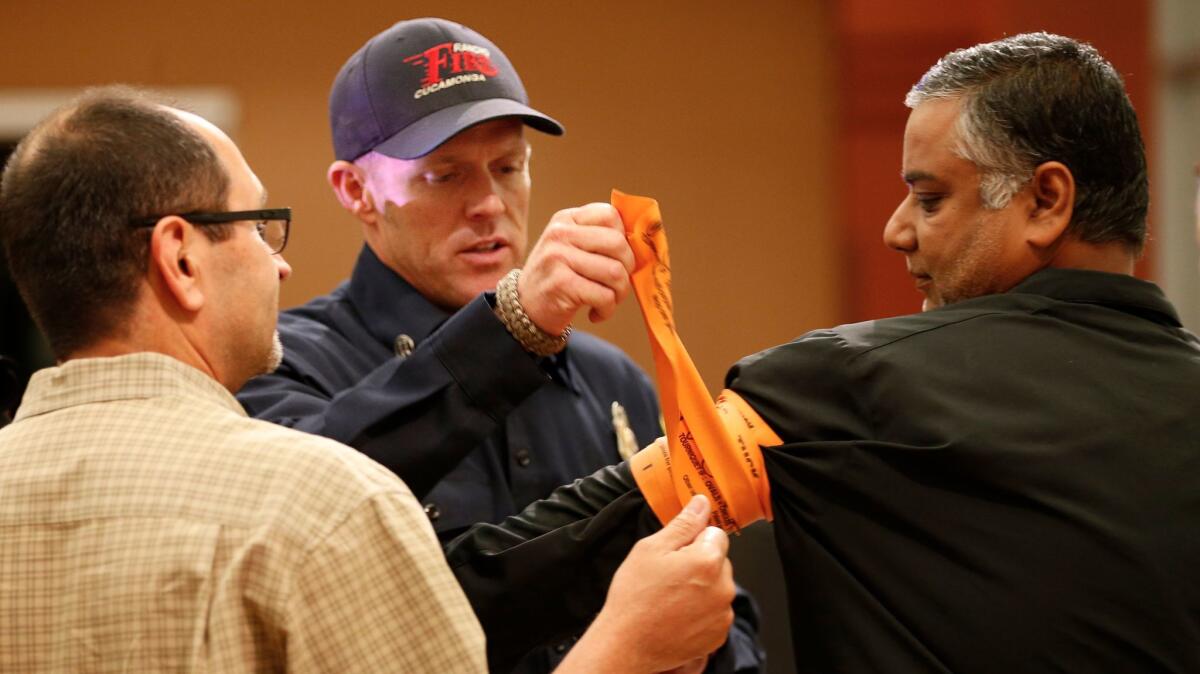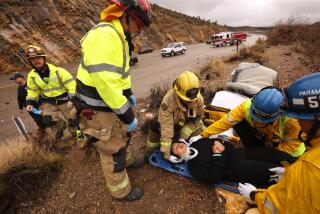You know CPR. Now firefighters want you to treat shooting and bombing victims

The images they were about to see would be gruesome: a woman bleeding out at the Boston Marathon, a video of a terrorist repeatedly stabbing a stranger. But the speaker asked the audience not to avert their eyes.
“You have to move past the fear, the terror, the disgust, and be very clinical about this and get to work,” said Rancho Cucamonga Fire Capt. Patrick Lewis.
For the last year, Rancho Cucamonga’s fire and law enforcement officials have teamed up to teach civilians how to triage and tie tourniquets on shooting victims, in the same way CPR is taught in case of emergencies.
They believe that people armed with these skills can save lives because they’re often the first ones at a crime scene. Many of those injured in the Boston Marathon bombing survived in part because bystanders started creating makeshift dressings and tourniquets before paramedics showed up, experts say.
“Who’s going to make the biggest difference? You guys,” Lewis told the group gathered on a recent Thursday evening.
Teaching civilians these battlefield techniques acknowledges what Lewis described as a sad reality: the near inevitability of shootings and terrorism.
Stop when the bleeding stops, not when the screaming starts.
— Capt. Patrick Lewis, Rancho Cucamonga Fire Dept.
Rancho Cucamonga fire and law enforcement officials began holding these classes in January 2016 — a month after 14 people were killed in a terror attack just 20 miles away in San Bernardino. They’d already been training city employees, but the nearby attack made clear everyone could benefit, said Ofer Lichtman, the fire district’s terrorism liaison coordinator who helped create the program.
That lesson was brought home this week, when a man entered a San Bernardino elementary school and shot a teacher and two students.
“Whether it’s a vehicle attack in Sweden, a church bombing in Egypt or an elementary school shooting in San Bernardino, the common denominators is that civilians are always there first,” Lichtman said. “We know it’s just a matter of time before this happens again.”
Lichtman and his team recently started providing active shooter training to local school administrators, teachers and high school students. The high number of fatal school shootings in recent years shows how necessary it is for schools to hold active shooter trainings, in the same way they regularly have earthquake and fire drills for students, he said.
“We need to wake up,” he said.
Speed is essential in treating gunshot victims.
Paramedics typically aim to arrive at a scene within eight minutes, but someone who’s been shot can bleed to death sooner. So anyone on the scene who can tie even crude tourniquets could perhaps save a life.
“Those people will buy us critical time,” Lichtman said.
So far, 6,000 civilians have been trained in Rancho Cucamonga, in addition to the city’s school and municipal employees, and law enforcement personnel from around the country who have traveled to the city.
During the recent three-hour training session, Lewis and his colleagues taught a variety of tactics, from how to disarm an active shooter to the proper way to carry someone who’s been seriously injured.
Among their tips: Run away from an active shooter if you can. If you have to hide, you can tie purse straps or a belt around door hinges to keep it shut. If you can’t flee or hide, fight back.
When trying to determine who needs first aid after an attack, move past people who aren’t breathing. Turn injured people on their side so their airways don’t get blocked if their tongue goes slack. Keep people warm if they’ve been shot so their body temperatures don’t drop dramatically.
Tie a tourniquet as tight and high as possible on someone’s arm or leg. Don’t be deterred if it seems painful.
“Stop when the bleeding stops, not when the screaming starts,” Lewis said.
Many of these skills were put to use at the Boston Marathon bombing in 2013, said James Hooley, chief of Boston’s emergency medical services agency.
A group of civilians carried victims into a nearby store before paramedics arrived and began using T-shirts to fasten dressings to stem bleeding, he said. Some even used shelving to make stretchers. Many of those helping were off-duty healthcare workers, as well as law enforcement and military personnel, Hooley said.
“With a population that’s even minimally trained, they can be a very good force multiplier,” he said.
When paramedics did show up, they were able to concentrate on the most severely wounded because victims had already been triaged, Hooley said.
The assistance of civilians is part of the reason the bombing’s death toll was only three even though hundreds were wounded, he said.
“That can make all the difference in survival,” said Hooley, who was chief during the bombing.
In 2015, the White House launched a national “Stop the Bleed” campaign, which aims to encourage Americans to treat bleeding after a serious injury, before first responders show up. They want people to be able to find the source of someone’s bleeding and apply pressure with a bandage and then a tourniquet if the bleeding doesn’t stop.
Dr. Matt Levy, the head of the Stop the Bleeding Coalition, a nonprofit that provides resources to people who want to teach these skills, said the effort isn’t just for responding to terrorist attacks, but also to workplace injuries or other accidents that could lead to dangerous hemorrhaging.
“My hope is that one day this will be taught in schools just like CPR,” Levy said.
Rancho Cucamonga’s curriculum goes beyond the fundamentals of Stop the Bleed and also includes how to properly evaluate an injured person and apply a seal for a chest wound.
Experts say it’s unlikely that good Samaritans in emergencies will make situations worse, and they’re protected by the law unless they do something grossly negligent or willfully harmful.
State Assemblyman Marc Steinorth (R-Rancho Cucamonga) introduced a bill after the 2015 San Bernardino terrorist attack that would put trauma kits with tourniquets, pressure dressings and chest seals in certain buildings in California. The bill is pending in the Legislature.
“We should be prepared were anything like that to ever happen again,” said Steinorth, who was formerly a Rancho Cucamonga city councilman and has attended multiple active shooter training sessions.
Brendiah Arnold, who lives in Rancho Cucamonga and showed up to the recent training, said her sister was caught in a theater several years ago in San Francisco where two men started shooting at each other.
“You just don’t know nowadays with people’s temperament what might happen,” she said.
Twitter: @skarlamangla
ALSO
New security measures adopted after deadly San Bernardino school shooting
‘One of our teachers got shot’: 911 tapes released of San Bernardino school shooting
More to Read
Sign up for Essential California
The most important California stories and recommendations in your inbox every morning.
You may occasionally receive promotional content from the Los Angeles Times.











